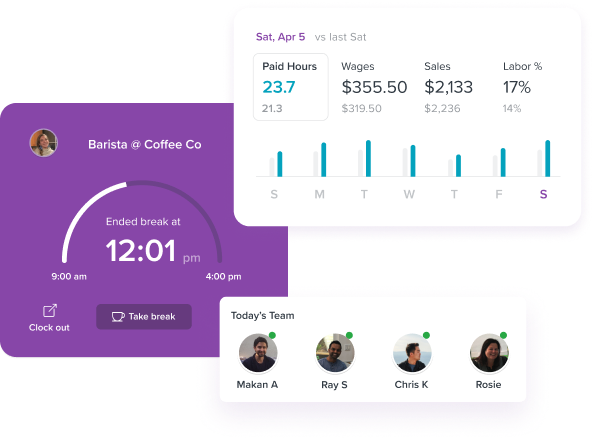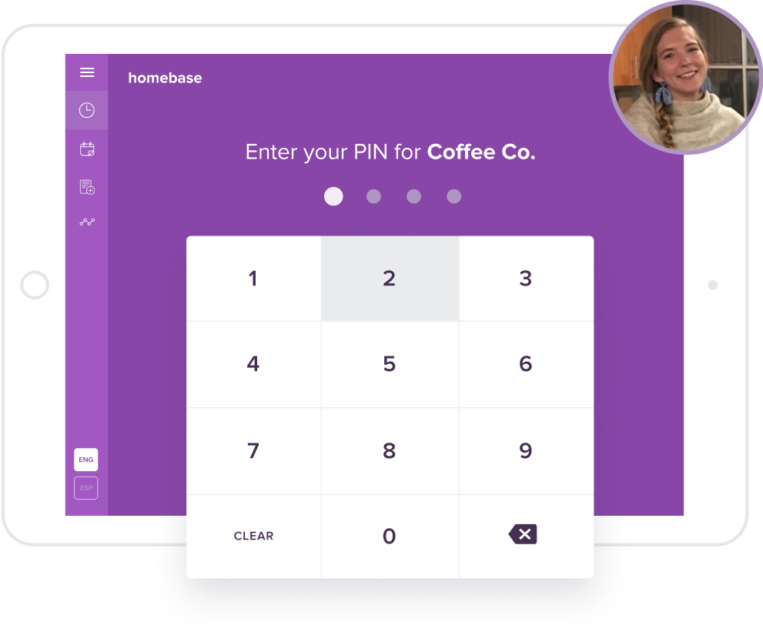4 different types of punch clocks and how they work
Punch clocks have come a long way over the last decade or so and now come in all kinds of different formats. Some have advanced features that go far beyond simple time tracking, like geofencing and clock-in photos. Here are the four most common types on the market right now.
1. Mechanical punch clocks
When an employee clocks in at the start of their shift, goes on break, or clocks out, they simply have to insert their paper time card into the punch clock’s slot. The punch clock then stamps the time card with a date stamp and the employee’s start and finish times. Then, when it’s time for employers to make their payroll calculations, they use these time cards to add up employee hours manually and put together their reports.
Because mechanical punch clocks don’t calculate employee wages automatically, you’ll need a time clock calculator (like Homebase’s free time clock calculator) to determine each employee’s pay.
Some employers prefer to use mechanical punch clocks at work sites where they don’t have access to computers or the internet, like in the construction and manufacturing industries. And although mechanical punch clocks don’t protect against “buddy punching” — which is when employees punch in for absentee co-workers — they may be a suitable solution for employers who want accurate time tracking and to prevent employees from inflating their work hours, which is a form of time theft.
2. uPunch time clocks
UPunch time clocks are electronic time clocks that work similarly to standalone mechanical time clocks. But with uPunch time clocks, you can also sync your uPunch data with cloud-based software and export the data to your payroll software for automatic wage calculations.
A notable difference between uPunch time clocks and mechanical punch clocks is that you can easily make necessary changes or updates to time card data with uPunch time clocks.
But remember, the uPunch time clock itself doesn’t connect to the internet or send data to uPunch cloud software automatically. However, it may be a good hybrid option for employers who want the simplicity of mechanical punch clocks while still being able to review employee hours and make adjustments where necessary.
3. Biometric time clocks
Biometric time clocks work similarly to regular time clocks but use biometric data to verify employee identities when they clock in. For example, biometric time clocks can use fingerprints, retina or iris scans, facial recognition, and even an employee’s voice to identify them.
Employers who want to avoid buddy punching find biometric time clocks particularly useful. And while they can help prevent many forms of time theft, they come with a set of disadvantages as well.
First, biometric time clocks aren’t legal in every state. And some states (like Illinois, Texas, Washington, and New York) have implemented laws regulating their use. With this in mind, employers who want to use them should research their state laws and will probably be required to:
- Get employee consent before gathering biometric data
- Notify employees about the data they’re collecting and explain what they’re using it for
- Follow all confidentiality, data storage, and information disposal regulations set by their state
4. App-based time clocks
App-based time clocks remove the need for external time punching devices and keep the entire clock-in-clock-out process online — all you need is internet access. With a web-based time clock solution, employees can sign into their shifts from a computer browser or from an app on their mobile devices.
Here’s what makes web-based options like Homebase’s free time clock software unique and effective:
- Employees enter their unique PINs to clock in or out of their shifts for more security without having to rely on biometric data.
- The app records staff members’ GPS locations and prompts employees to take clock-in photos to prevent early sign-ins and buddy punching.
- Systems like Homebase even store cloud-based time and attendance data for up to four years, which is two years longer than The Fair Labor Standards Act (FLSA) legal requirements.
The additional advantage of web-based solutions is that they can integrate with your payroll system, so you don’t have to export data like you do with uPunch clocks.
The biggest punch clock challenges and how to overcome them
While punch cards make for very accurate employee time tracking, they come with some potential challenges. Here are some of the most notable punch card drawbacks and how to overcome them.
Difficulty tracking buddy punching and time theft
Employers can’t — and shouldn’t have to — constantly monitor every employee who punches in and out. And they definitely don’t have the time to track down every staff member who forgets to clock out for their break. This is how time theft — even unintentional time theft —happens. And even if it only occurs in small increments, it can add up.
Instead of moving to a biometric solution — which could put you at risk of legal issues and negatively impact the employee experience — a web-based time clock is your best bet. Web-based systems give you more security as they require employees to clock in and out with unique PINs. They can even show you where employees clock in and clock out from. And because web-based time clocks make it easier to track employee hours in real-time, you’ll be able to catch and fix any discrepancies in employee hours before they get out of hand.
Inability to track remote employees
Mechanical time clocks can’t track remote employees who have to travel to job sites outside of brick-and-mortar locations and offices. That means remote team members have to make the trip to a central workplace to clock in before beginning their work days.
To keep track of remote employees without asking them to come into the office to sign in, many business owners rely on web-based solutions like Homebase. That way, any staff member who has access to a phone and the internet can easily clock in and out without relying on a physical punch clock. And they can do so securely.
Legal issues surrounding biometric time clocks
Although they do provide an added layer of accuracy and security, biometric time clocks aren’t always legal. And some employees find them invasive.
If you choose to implement a biometric time clock, research your state laws on storing and processing the personal data you collect. And remember that you have to get employee consent before using biometric solutions.
And don’t forget that you can always move to a web-based solution if a biometric clock causes too much trouble. You’ll get the same amount of security and won’t have to worry about invading employee privacy or running into compliance issues.
Features that make Homebase the best punch-in clock app
With Homebase, you don’t have to worry about traditional punch clocks and their shortcomings. You can have an accurate, compliant, and easy time clock experience with our web-based app.
Accurate employee tracking
Physical punch clocks aren’t always convenient — they make it difficult for off-site or on-the-move employees to sign in and out of their shifts and can present logistical issues. And they also don’t make it easy to keep accurate records. The managers responsible for manually entering time card data for payroll and central records can still make mistakes in the data entry process.
That’s why the fact that our free time tracking app automatically converts employee hours into timesheets for payroll is such a serious benefit. We even track breaks and let you know when overtime is approaching for individual employees. That way, you don’t have to worry about human error or bias getting in the way of dependable record keeping.
Compliance
Staying on top of your state, local, and federal labor laws is one of the more stressful parts of managing employee time and attendance. But that’s one of the best things about Homebase — it helps you stay compliant, too.
When employees clock in and out, the app automatically tracks breaks and overtime. You’ll even receive alerts when someone is about to hit overtime, so you don’t have to worry about violating any labor laws.
Paid time off (PTO) tracking
Homebase automatically tracks employee paid time off or paid sick leave, so you don’t have to calculate the accruals yourself. And when team members are ready to make time off requests, they can do it straight from an app on their phone.
Here’s how it works:
- When employees clock in and out, Homebase instantly calculates how many PTO hours they’ve accumulated based on your PTO and sick leave accrual policy.
- Employees submit their time off requests from their mobile app, so managers can approve or deny them easily. Employees just need to log in to their Homebase account and select “request time off.”
- When team members request their PTO, they can ask for either the whole day off or a specific amount of time.
Reporting
Without real-time access to employee hours reports, it’s a lot easier to miss both time tracking mistakes and genuine instances of time theft.
A web-based application like Homebase can give you an overview of employee hours so you can spot patterns that show recurring mistakes or time theft before they snowball into a major problem. And Homebase’s time clock reports can also help you track overtime trends and monitor your labor costs.
Make time tracking simpler and more secure with Homebase
Punch clocks provide a more accurate way of time tracking than Excel spreadsheets, it’s true. But they can’t help you stay ahead of time theft while also keeping your business compliant.
A web-based time tracking solution can, though. And as a user-friendly human resources software designed specifically for small businesses and hourly teams, Homebase also takes other team management issues off your plate with tools for payroll, employee scheduling, team communication, and HR and compliance.


